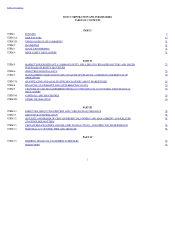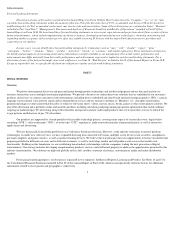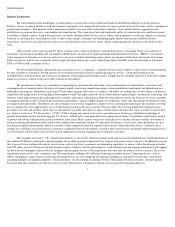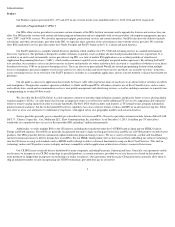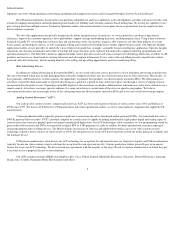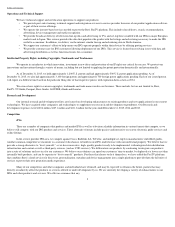TiVo 2015 Annual Report Download - page 12
Download and view the complete annual report
Please find page 12 of the 2015 TiVo annual report below. You can navigate through the pages in the report by either clicking on the pages listed below, or by using the keyword search tool below to find specific information within the annual report.
Table of Contents
enhancements developed by us would not be found to infringe patents that are currently held or may be issued to others. There can be no assurance that
we are or will be aware of all patents that may pose a risk of infringement by our products and services. In addition, patent applications are generally
confidential for a period of 18 months from the filing date, or until a patent is issued in some cases, so we cannot evaluate the extent to which certain
products and services may be covered or asserted to be covered by claims contained in pending patent applications prior to their publication. In general, if
one or more of our products or services were to infringe patents held by others, we may be required to stop developing or marketing the products or
services, to obtain licenses to develop and market the products or services from the patent holders or to redesign the products or services in such a way as
to avoid infringing the patent. This could have an effect on our ability to compete in the IPG or entertainment technology marketplace.
Data Services
In the database and data services area, we compete with other providers of entertainment
-
related content data such as Amazon.com
’
s Internet
Movie Database ("IMDB"), Gracenote (a subsidiary of Tribune Media Company) and Ericsson Broadcast and Media Services (formerly Red Bee Media)
and FYI Television, Inc. While we do not believe that our competitors' data sets are focused on exploration, discovery, and content management in the
same way that our data is, they present competition to our data services business.
Content Security Technology
Our analog video content security solutions are proprietary and have broad U.S. and international patent coverage. We have an analog content
security solution that has been widely deployed on commercial products that significantly distorts or inhibits copying by PVRs, including DVD recorders
and hard drive recorders with an analog out. With the increase in content distribution over the internet, and with the continuing advance of digital content
and high
-
definition formats, our analog video content security solutions that protect standard definition content on optical media and digital PPV/VOD
signals are viewed by some of our customers as being less important than the other digital and network content protection solutions. Our content security
technology therefore faces the risk of content providers choosing not to copy protect their content or CE manufacturers ceasing to produce PVRs with an
analog out.
Legislative and Regulatory Actions
A number of government and legislative initiatives have been enacted to encourage development and implementation of technologies that protect
the rights and intellectual property of the content owners. For example, the U.S. and other countries have adopted certain laws, including the Digital
Millennium Copyright Act of 1998 ("DMCA"), and the European Copyright Directive, which are aimed at the prevention of piracy of content and the
manufacture and sale of products that circumvent copy protection technologies, such as those covered by our patents.
Compatibility Between Cable Systems and Consumer Electronic Equipment
The Federal Communications Commission ("FCC") has been working for over a decade to implement a congressional mandate that it create a
competitive market for cable television set
-
top boxes and other devices to access video programming on cable systems (“navigation devices”
)
and give
consumers a choice in the device used to access such programming, while still allowing the cable systems to have control over the secured access to their
systems.
To meet its statutory obligation without compromising the security of video services, the FCC required cable systems to make available a security
element (now known as a CableCARD) separate from the basic navigation device needed to access video program channels. In 2003, the FCC adopted
regulations implementing an agreement between cable television system operators and CE manufacturers to facilitate the retail availability of so
-
called “plug
and play” devices that utilize unidirectional CableCARDs, including digital televisions and other digital devices that enable subscribers to access cable
television programming without the need for a set
-
top box (but without the ability for consumers to use interactive content). Due to certain legislative
developments in the U.S., cable subscribers may be able to utilize interactive and other two
-
way services without the need for a set
-
top box, meaning that
consumers could use an IPG built directly into a TV to access and operate their cable subscriptions and not need to purchase or rent a set
-
top box from the
cable operator. Although FCC regulations no longer prohibit multi
-
channel video service providers from deploying navigation devices with combined
security and non
-
security functions acquired after July 1, 2007, further developments with respect to these issues could impact the availability and/or
demand for “plug and play” devices, particularly bi
-
directional devices, and set
-
top boxes, all of which could affect demand for IPGs incorporated in set
-
top
boxes or CE devices.
10



